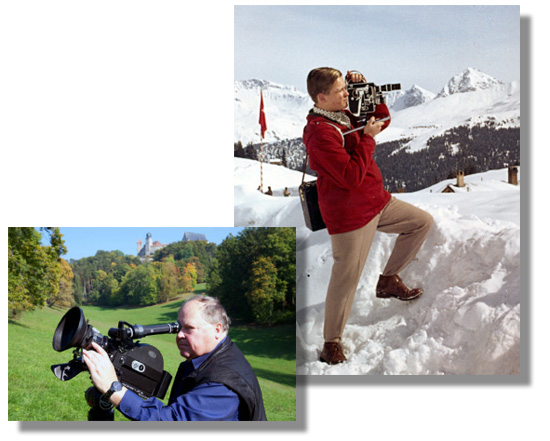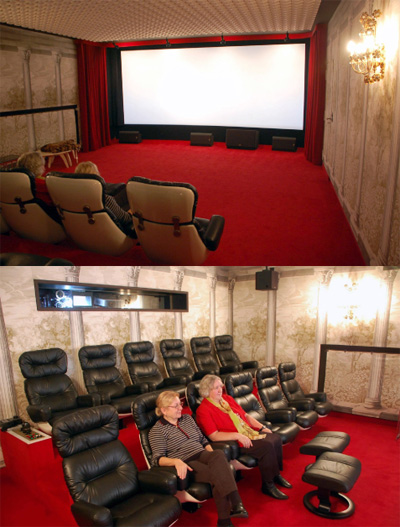The man with the camera. Coburg's film historian |
Read more at in70mm.com The 70mm Newsletter |
| Written by: Manfred Romboy, DGPh. Copyright „Photo Antiquaria“ Club Daguerre | Date: 27.09.2015 |
 Jürgen
A. Brückner, Coburg's film historian, with his 16 mm single lens reflex
camera „SR16“ by Arnold & Richer in the Court Garden of the famous Coburg
Fortress. At the age of 18 Jürgen could make the transition to 16 mm size.
First camera: a Bolex H 16 with three lenses in the turret. (Brückner-archive). Jürgen
A. Brückner, Coburg's film historian, with his 16 mm single lens reflex
camera „SR16“ by Arnold & Richer in the Court Garden of the famous Coburg
Fortress. At the age of 18 Jürgen could make the transition to 16 mm size.
First camera: a Bolex H 16 with three lenses in the turret. (Brückner-archive).Jürgen A. Brückner, born in 1941, virtually inherited the passion for films. In 1938 his father, Rudolf Brückner, a factory owner in Coburg, bought a Siemens film camera. His father bought the camera so that he could film both of his sons at the time. Whether at children's birthday parties or school parties one could always hear the purring sound of father's film camera which was very much part of these events. It was no surprise that the crafty Jürgen managed to get his father´s camera´s up and running when he was a child. This meant that much of his fathers stock of undeveloped film got drastically reduced! In 1955, after his 14th birthday, he got his first film camera: the fancy „Movikon quer“, a camera for the double 8-films which had been on the market since 1932. However, these films were in fact 16 mm wide and rolled on a 7,5 m fitting daylight spool. Initially only half of the film was exposed in the camera, then the film passed over the aperture a second time. During the developing stage this 16 mm wide film was centrally separated in the film laboratory. The amateur got 15 mm film on a reel which was only 8 mm wide. The „Movikon quer“ was the first substandard film camera developed by the West German company Zeiss Ikon AG after the Second World War and for shooting it was held like a camera with both hands directly in front of the eyes. |
More in 70mm reading: Der Mann mit der Kamera. Coburgs Filmchronist Traumreise Unter Weissen Segeln Der Reisefilm "Flying Clipper – Traumreise unter weißen Segeln" in Deutschland und in den USA MCS 70 Superpanorama Camera on Display in Schauburg The Passing of Hannelore Bollmann Cantor 2012 gallery Saturday New 70mm print of "Flying Clipper" Internet link: Kinematek Coburg |
|
At that time the considerably more expensive film size 16 mm and it’s cameras were advertised with the slogan „For the ambitious amateur“. Certainly Jürgen Brückner was ambitious. When he was 18 years old he bought a „Bolex H 16“-camera with three lenses in the turret. As a 16 mm film-maker he could also archive the „higher film specifications“. Because of that he established the „Coburg film club“. However man does not live by films alone. Jürgen completed his schooling and obtained secondary school level. Despite his great dream to become a cameraman he started an apprenticeship as a machine fitter, following in his fathers footsteps. When Jürgen finished his apprenticeship he really wanted to move from the small town of Coburg to the film metropolis of Munich. His parents always had in mind that his brother should take over the family enterprise and this allowed him to move to Munich and attend a business school. In addition to his new schooling Jürgen tried to make new contacts with film-makers in Munich and also took a course to become a cameraman offered by a private institution. It was only in 1966 that the University for Film and Television was founded in Munich. Perhaps Jürgen Brückner could have persuaded his father to finance his film studies and perhaps he would have been able to go to Hollywood like Michael Ballhaus. Perhaps, perhaps, perhaps! However, not before too long both his uncle and his brother died in Coburg and Jürgen was asked to return in 1966 to become the successor in the family machine building company. First as sales manager and then from 1980 onwards as managing director of Gustav Brückner GmbH. Pro´s and con´s for a factory owner's son. A pro in so far that Jürgen A. Brückner could develop his skills with both the „Bolex-camera“ and also the „Arriflex SR“ safe in the knowledge that he was in a financially secure family situation. |
|
 Brückner's
home cinema with a screen which is two meters high and five meters wide. The
auditorium is six meters wide and eight meters long and has ample space for
private guests. (photo: Romboy). Brückner's
home cinema with a screen which is two meters high and five meters wide. The
auditorium is six meters wide and eight meters long and has ample space for
private guests. (photo: Romboy).In 1968 the Bavarian Broadcasting acquired the services of the self-taught cameraman with all of his professional equipment. For the series „Unter unserem Himmel“ he filmed underwater sub-marine shots for the film „Spaziergang unter Wasser“. In 1971 he also acted as film merchant and acquired the movie rights for his favorite movie, the feature film "Flying Clipper - Traumreise Unter Weissen Segeln" which was produced in 1962 in 70 mm film size. A feature-length movie about the trip of a Swedish sailing ship used for training across all parts of the Mediterranean Sea. It was largely thanks to Jürgen Brückner that the film returned to cinema’s once again – in both 70 and in 35 mm size. Copies were also created for both 16 mm and super 8 projectors. There was no money in it for Jürgen – he was just glad that no losses we incurred during this adventure into the film industry. During the time he collected used 35 mm feature film prints which he could then screen in a moderate low-rise building next to his parents' house. Whenever Jürgen had free time he was filming. The films „Oktoberfest“ and „König Ludwigs Schlösser“ where ordered from his archives, plus he also had a lot of industry and advertising film opportunities. Meanwhile Jürgen not only had film know-how but also purchased the highly professional „SR-16“ Arriflex-camera and his productions where rather impressive. In 1982 there was a royal visit to Coburg. The Swedish royal couple, Carl Gustav and his wife Sylvia, visited Coburg where they have family ties. Naturally Jürgen Brückner was present with his camera during the whole event. There was an opportunity to remind the king of times they had together in the past: in the Court Garden in Coburg when Brückner was 13 years old he had to take care of the heir to the throne who was 6 years old at the time. Carl Gustav's grandmother, duchess of Coburg, was a friend to Brückner's grandmother. During the heir's visit they often said: „Jürgen, take care of the Gustav“! Film-making was always an important part of Jürgen´s life. He decided that he wanted to get into the more demanding 35 mm cinema size and out of this the 45 minute film „Spaziergang nach Syrakus“ and several other advertising films arose. What is worth mentioning is that they were not made to make money but rather came out of a passion for film. Jürgen also somehow managed to find time in between his busy film hobby to marry in 1973 and became the father of two children. As a newlywed Jürgen needed to plan his new home and priority was given for a home cinema in the basement. The dimension of the cinema was a result of the desired projection screen size. Being a fan of large screens he decided that a screen of 5 x 2 meters was required. With a projection distance of 8 meters and a width of 6 meters for the auditorium a remarkable home cinema was born which would give the cinemas of Hollywood stars a run for their money. Additionally available: a projection room with projectors and amplifiers, of course for the film sizes 35 and 70 mm. On the same floor there is also a large stock of film prints plus a cutting room for 16 mm film. When Brückner's architect was faced with various demands for the basement he said: A proportionate house must be built on top. And this is what was done. |
|
|
More and more of Brückner's film activities were talked about in the Coburg area and he received a lot of historical film strips as a result of donations, discoveries in lofts and from private and public archives. As a result his film archive „Coburger Filme from 1924 – 1985“ developed rapidly (available under kinemathek-coburg.de“ on DVD). Another notable achievement is when Jürgen became board member of the „Coburger Historische Gesellschaft“. Under the title „Franken schwarz-weiß – die ersten Filme aus Coburg“ the Bavarian Broadcasting created a 45 minute film together with Jürgen Brückner. Jürgen who is now 73 years old retired from his family business a few years ago. This means more time for films. Currently you can find more than 1300 feature films in 35 mm and 30 films in 70 mm size in his archive, stored in every corner of the house! His wife Johanna is not that thrilled to be living with so many film reels however she sometimes cannot hide the fact that she is rather proud of her husband's „film career“. Although Jürgen is not officially a collector of film equipment in 2013 he couldn’t resist purchasing the old 65 mm film camera which was used for filming "Flying Clipper", „Onkel Toms Hütte“, „Old Shatterhand“, „Der Kongress amüsiert sich“, „Die schwarze Tulpe“ and „Die Verfluchten der Pampas“. Today in addition to the existing cinema projectors a brand new SONY 4-K projector can now be seen in his projector room. Jürgen A. Brückner is also a member of the Club Daguerre. Copyright „Photo Antiquaria“ Club Daguerre |
|
| Go: back - top - back issues - news index Updated 22-01-25 |
